
|
Sale 8
Coin and Currency Auction
| Lot |
Photo |
Description |
Realized |
Lot 1 |
|
Oak Tree Shilling 1652. PCGS graded VF-25. Antique silver in color and unevenly struck, as usual. The surfaces show a couple of shallow handling marks, nothing important or noteworthy. There is a planchet defect at 9 o'clock on the obverse, clear through the planchet to the other side, with a small missing piece of metal there, as made. An affordable example of this rare coin, which is seldom found better.
Estimated Value $2,500 - 3,000.
View details
| Realized
$2,760 |
Lot 2 |
|
Pine Tree Shilling, large planchet 1652. PCGS graded AU-50. One of the nicest of the Pine Tree shillings this cataloger has seen, the planchet is full and round, with a small edge void near the top of the obverse, perhaps where some metal was "shaved" or maybe as made. The strike is sharp, with excellent detail on the tree and peripheral lettering. Lovely steel gray in color with hints of color dancing in the fields. Minor waviness in the planchet, as always, and highly popular with collectors.
Estimated Value $6,000 - 7,000.
View details
| Realized
$7,188 |
Lot 3 |
 |
Pine Tree Shilling, small planchet 1652. PCGS graded VF-30. This coin appears to be Noe-29, with the D in ENGLAND first rotated 180°, then corrected. A choice coin for the grade, the fields are a natural medium gray color, while the devices are uniformly lighter in color. Well centered and struck, with the M is obviously double cut on the obverse. Trouble-free wear and surfaces, without planchet problems. Die steel for coinage was very hard to come by in early America, hence dies were used and reused and then used some more to strike desperately needed coinage. When a die cracked or broke, it was repaired by either lapping down the surfaces or reingraving the devices (sometimes both). Many coins reflect the worn or broken condition of the dies, and it is evident that a great struggle was unfolding to keep the first authorized silver coinage in circulation. About as nice as these are found, PCGS has yet to grade any in mint state of this size and type.
One of the first colonies set up in what later became this country, was the Massachusetts Bay Colony. As the population grew, the need for coinage or some circulating medium grew also. In the 1630s a loose barter system prevailed, any "hard currency" (copper, silver or gold) was siphoned off back to Britain through both taxes and by selling the colonists goods at inflated prices. Purchases were made by trading goods for goods: furs, fish, grain, musket balls, wampum, shells etc…. The only coins in circulation in Massachusetts at the time were outdated English farthings and presumably Spanish silver, which would have been used by passing merchant ships and buccaneers stopping by Boston as a port of call. King Charles I of England was executed, and his forces were defeated by 1651, thus the royal regulations governing the Colony were no longer relevant. The General Court of the Massachusetts Bay Colony authorized John Hull and Robert Saunderson to strike much needed silver in the denominations of XII Pence or Shilling, VI Pence and III Pence in mid 1652. The first coinage was the NE issues, followed a year later by the Willow Tree issues, later Oak Tree Issues and finally the various Pine Tree issues. The date 1652 was continuously used for decades, as the Colony had no technical authority to strike its own coins. Later, when King Charles II restored order in England, he allowed the coinage to continue, after paying the King's taxes.
Many of the large size Oak Tree and Pine Tree pieces were bent as the 1692 Salem witch trials unfolded, as the local citizens believed that carrying a bent silver coin would offer protection from witches. For this reason, Hull made the planchets smaller, but thicker, to make the coins harder to bend, and harder to "clip" silver off of by shaving the edges, spending the lighter weight coin, and keeping the silver shavings for recoining.
Massachusetts silver coins are among the most important colonial issues, as they were the first silver coins struck in the continental United States, they circulated widely, including Canada and even caused one of the first American uprisings against Britain, when Hulls coinage came into question by Royal authorities.
Estimated Value $2,000 - 2,500.
Purchased from Ira S. Reed 6/13/44 for $25.00.
View details and enlarged photos
| Realized
$2,875 |
Lot 4 |
|
St. Patrick Copper "Farthing". PCGS graded EF-40. With some minor pitting on both sides, but even chocolate brown in color and with nice surfaces otherwise. Typical weak strike.
Estimated Value $600 - 800.
View details
| Unsold |
Lot 5 |
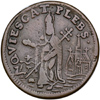 |
St. Patrick Copper "Farthing". PCGS graded VF-30. The obverse design of St. Patrick holding a harp, with crown above, reverse of St. Patrick holding a cross, with church behind, and administering to various sea creatures. QUIESCAT PLEBS on reverse refers to "let the commoners be quiet" a reference to authorities desire to quiet the embarrassing political songs and verses commonly sung by the populace. Known as "Newby's coppers" after he brought over large numbers for circulation in the Quaker Colony of New Jersey in America. Choice chocolate brown in color, with the familiar large brass splasher on the crown (used to represent the gold in the crown rule), the splasher was put onto the planchet before striking. Minor surface fissures on the obverse, and this may have been struck by roller dies. Problem free for the issue, and desirable.
Estimated Value $500 - 750.
Ex: Ira S. Reed, 7/21/44 at $3.
View details and enlarged photos
| Realized
$1,208 |
Lot 6 |
 |
St. Patrick Halfpenny. PCGS graded EF-40. Choice chocolate brown in color, with hints of darker colors adhering to the devices. Typical strike for the issue, with upper devices poorly defined. One small mark below the R of REX, and a rim bruise over the X. Over 120 varieties exist of this type coin, confirming that the original number struck must have been very large.
Curiously, these were struck in 1641/42 at the Tower Mint in London. After Charles I was executed and the Puritans suppressed everything Catholic, these coins went into hiding, as possessing them was a crime. After Charles II came to power in 1662, the St. Patrick coins returned to circulation in Ireland, where they circulated for a time, until 1679 when they were declared uncurrent. The farthings and half pennies still circulated in Ireland.
Mark Newby was a Quaker and had experienced religious persecution in the Dublin area, Newby decided to join his fellow Quakers in their American settlement in New Jersey. Thinking that small change may be in short supply, Newby purchased £30 of these coppers, approximately 14,400 pieces. Newby arrived in America in late 1681 and was soon politically well connected, enough so to get his coppers declared legal tender. Newbie died in 1682, but the coppers he brought over circulated for well over 100 years, in fact Dr. Edward Maris stated that he had received these coppers from circulation as a boy in the early nineteenth century.
Estimated Value $1,250 - 1,750.
Ex: Ira S. Reed, 3/3/46 for $10.
View details and enlarged photos
| Realized
$2,760 |
Lot 7 |
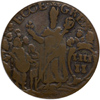 |
St. Patrick Halfpenny. PCGS graded Fine-15. Choice light brown in color and well struck and preserved. There is a minor planchet crack near the R of REX. A scarce coin, and this one should be worth a premium for its obvious qualities.
Estimated Value $400 - 500.
View details and enlarged photos
| Realized
$1,898 |
Lot 8 |
|
(1688) James II Plantation Token tin farthing. PCGS graded MS-60. These tokens were the first coinage authorized for the British Colonies in North America. They are struck in pure tin, and always have rough surfaces. Boldly impressed by the dies, with details on the rampant horseman and with flecks of tin showing through the dark patina on the reverse on the upper devices. Rare in this grade, only 2 have been so graded with 3 higher by PCGS.
Estimated Value $2,000 - 2,500.
View details
| Realized
$1,725 |
Lot 9 |
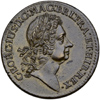 |
Rosa Americana Twopence (undated). PCGS graded AU-58. Struck in 1722, although not dated. Deep chocolate brown in color with only a few signs of minor spotting. Boldly struck and well preserved, and perfect for the specialist. The reverse die was rotated 90° clockwise when this one was struck, and most of the reverse shows slight doubling from the strike. A trace of raw copper on the upper points at the center of the rose.
Estimated Value $2,000 - 2,500.
View details and enlarged photos
| Realized
$2,300 |
Lot 10 |
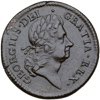 |
1723 Rosa Americana Penny. Sharpness of EF-40 but slightly porous. No stop after small 3. Dark chocolate brown in color and well struck by the dies. The surfaces are slightly porous, but not enough to detract. On the upper left obverse rim there is some flattening, as well as two minor planchet fissures nearby. Still nice in appearance, even with its problems.
Estimated Value $50 - 100.
Ex: Ira S. Reed, 6/44 at $4.
View details and enlarged photos
| Realized
$414 |
Lot 11 |
|
1723 Rosa Americana Twopence. PCGS graded AU-55. Weight: 214.3 grains. Medium brown in color, but the surfaces show light porosity on both sides, visible with the aid of a glass. Sharply struck and with clean surfaces. Struck a hair off-center towards 10 o'clock on the obverse, same direction on the reverse.
Estimated Value $1,000 - 1,500.
View details
| Realized
$1,150 |
Lot 12 |
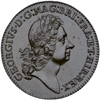 |
1723 Rosa Americana Twopence. PCGS graded AU-55. Stop after X, not after 3. William Wood owned tin and copper mines in England. Using his considerable political clout, Wood obtained a patent authorizing him to coin up to 100 tons of base metal (from his mines) for use in the American plantations. To keep the coins from circulating at home in England, the patent authorized them to be lighter in metal content than the current denominations in England. The coins were struck from 75% copper, 24.7% zinc and .3% silver, which is a form of brass.
The surfaces of this piece are quite nice, there is a very minor planchet flaw below the chin, and a short planchet fissure at 7 o'clock on the obverse that goes through to the reverse. Brassy brown in color, with excellent striking definition on King George's hair.
Estimated Value $1,000 - 1,500.
View details and enlarged photos
| Realized
$1,438 |
Lot 13 |
|
1722 Hibernia Halfpenny, harp at left. PCGS graded MS-63 Brown. Weight 100.2 grains. A scarce and popular Guide Book type coin. Struck from lightly rusted dies on the obverse, and with some red areas on the reverse. Sharp and one of only 2 graded as such by PCGS, with 2 graded higher.
Estimated Value $1,200 - 1,400.
View details
| Realized
$1,380 |
Lot 14 |
|
1722 Hibernia Halfpenny, harp at left. VF-20. Eleven harp strings. With a tiny planchet defect on the obverse edge at K12½. A few small nicks on the lower obverse. Medium dark steel brown. An appealing colonial that is well preserved and free of any sort of problem.
Estimated Value $200 - 300.
View details
| Realized
$299 |
Lot 15 |
|
1723 Hibernia Farthing, "D:G: REX". PCGS graded MS-64 Brown. When available, the weights are included from our consigner, of course, once in a PCGS or other grading service holder, the weights are subject to guesswork only, unless removed from the holders. This one has superb surfaces for the grade, We note a couple of minor ticks on Georgius chin, blended well with the color, and a tiny mark on the reverse at Liberty's belly button. Glossy brown in color, with a few very small specks on the reverse. One of just two coins graded this high, and seldom offered in grades even approaching this. Sharply struck and a premium coin in every way.
William Wood had won his way into a Royal Patent to produce coins using copper from his mines in England. However, King George I's mistress absconded with Wood's Royal Patent and she demanded a ransom for its release. Paying the ransom greatly increased Wood's costs, and in order to recover some of the ransom money, he struck coins of light weight, thereby increasing his profit, but cheating both the Irish and American Colonies of fair value, and breaking his duty under the patent. The Irish rejected the coins, and they were eventually foisted on the American Colonies, where they circulated widely. The trials of the early coiners make for most interesting study.
Estimated Value $1,200 - 1,400.
View details
| Unsold |
Lot 16 |
|
1723 Hibernia Farthing, "DEI GRATIA REX". PCGS graded MS-64 Brown. Sharply impressed by the dies and wonderfully preserved. Hints of mint red in some of the letters, but generally an even brown color, with no problem spots or detractions. Struck on a clean planchet and certainly one of the best to survive of this important colonial issue.
Estimated Value $800 - 1,000.
View details
| Realized
$719 |
Lot 17 |
 |
1723 Hibernia Farthing, "DEI GRATIA REX". PCGS graded AU-58. Chocolate brown in color and with delightful surfaces. A few minor planchet imperfections at the top of the reverse with dark color noted on some minor flecks in that area. Brown luster in the fields, and well struck.
Estimated Value $350 - 500.
View details and enlarged photos
| Realized
$334 |
Lot 18 |
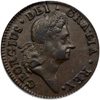 |
1723/22 Hibernia Halfpenny. PCGS graded AU-53. Period before HIBERNIA. Small 3. With blunt striking in the central areas on both sides and a small planchet defect on the obverse edge at K11½. Pleasing medium dark chocolate brown surfaces.
There is a die crack up through the top leaf out the rim on the obverse, and one on the reverse through the tops of IBE. A highly appealing coin.
Estimated Value $500 - 650.
View details and enlarged photos
| Realized
$483 |
Lot 19 |
 |
1723 Hibernia Halfpenny. PCGS graded MS-63 Brown. No period before HIBERNIA. Quite well struck with full beading on both sides. Flawless medium dark chocolate brown with traces of faded mint red throughout the obverse. There is a short die line into the field below the R of REX, and the X is recut.
Estimated Value $500 - 650.
View details and enlarged photos
| Realized
$518 |
Lot 20 |
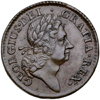 |
1723 Hibernia Halfpenny. PCGS graded AU-55. These were originally struck by William Wood who obtained an authorizing Royal Patent to strike these for Ireland. However, they were unpopular as the patent allowed them to be well underweight when compared with then current coinage in England (60 halfpence to the pound in Ireland as compared to 46 halfpence to the pound then current in England). The Irish people were outraged and refused the coins. Speculators purchased them at bullion value and shipped them off to America, where they circulated for a century or more.
Chocolate brown in color with some areas of reddish color, and with some minor verdigris tucked in with the devices. Sharply impressed by the dies, and a perfect example to represent this important colonial issue.
Estimated Value $350 - 450.
Ex: Ira S. Reed, 7/44 as "V. Fine" for $3.50.
View details and enlarged photos
| Realized
$322 |
Lot 21 |
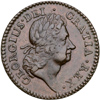 |
1724 Hibernia Halfpenny. PCGS graded AU-50. Stop after date. Struck from worn dies, the obverse with a light crack through GEORGIU, and a rim crack to the bust point. The reverse die appears to have been lapped, as the central definition is indistinct, and some of the harp strings are played out. Examination makes us uncertain that the color is original, as it remains slightly uneven with hints of mottling. Free of circulation problems or other detractions.
Estimated Value $600 - 800.
View details and enlarged photos
| Unsold |
Lot 22 |
 |
1773 Virginia Halfpenny, period after "GEORGIVS". PCGS graded MS-64 Red and Brown. This specimen boasts nearly full red color on both sides, it is well struck and centered, and shows very few signs of handling. Free of the usually seen spots, and an exceptional example of this important colonial issue.
Virginia, unique among the original thirteen colonies, received royal authorization to coin its own money (1609). No one bothered though, and tobacco remained the standard medium of exchange for the first 150 years. Accordingly, the Virginia Assembly (1773) passed an act authorizing coinage pursuant to the Royal Charter, and the royal authorities approved. The Tower Mint in London shipped over 5 tons of halfpence in 1773. The timid Virginia Treasurer demanded a Royal Proclamation before he would release the coins into circulation, fearing his actions could be construed as treasonous without such authorization. Nearly a year later, the Royal Proclamation arrived, meanwhile the Revolution was on the verge of erupting. All coins were hoarded at the time, as people prepared for war.
Even with their English ties, these coins did circulate, and have been recovered at American historical sites. Most of the Uncirculated examples were found in a keg which was found in Richmond just prior to the Civil War.
Estimated Value $500 - 800.
View details and enlarged photos
| Realized
$1,150 |
Lot 23 |
|
1773 Virginia Halfpenny, period after "GEORGIVS". Fine-12. One minor rim mark at 7 o'clock on the obverse, medium dark brown in color.
Estimated Value $50 - 75.
Ex: Ira S. Reed 6/44 for 50¢.
View details
| Realized
$75 |
Lot 24 |
|
1773 Virginia Halfpenny, no period after "GEORGIVS". PCGS graded MS-65 Brown. One of the finest graded of this issue, only 5 have been graded this high in Brown, with a single coin graded Red Brown by PCGS as gem, there are none graded higher. Superb surfaces, well centered and struck. One small red spot below the lion in the upper left of the shield. Medium brown in color and an outstanding coin for the grade.
Estimated Value $700 - 900.
View details
| Realized
$1,323 |
Lot 25 |
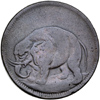 |
(1680) London Elephant Token Halfpenny. Thick planchet. PCGS graded EF-40. Although the actual year struck is not known, it is believed they were coined in the period 1666 to 1690, with the dates 1672 and 1680 most commonly quoted. The reason behind the production of this piece is unknown, but the reverse provides a clue in GOD PRESERVE LONDON that they were made after the devastating London fire of 1666 and the plague of the same year. We do know that some of these apparently came over with Mark Newby's "St. Patrick" coppers, as elephant tokens have been found in non-collector accumulations in New York and New Jersey of the period (Breen).
Clean surfaces for the grade, the coin is evenly toned a dark chocolate brown throughout. Struck from worn dies, with some of the reverse letters drawn to the rim.
Estimated Value $800 - 1,200.
Ex: Ira S. Reed, 7/21/44 for $3.50.
View details and enlarged photos
| Realized
$1,035 |
Lot 26 |
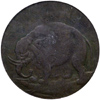 |
(1680) London Elephant Token Halfpenny. "LON DON". PCGS graded VF-20. Called "very rare" by Breen, this one is nice for the grade, with dark brown toning and decent surfaces. A couple of minor pits can be seen on the obverse, along with some trivial rim ticks. This variety is the famous "Godless" halfpenny, as the usual motto GOD PRESERVE LONDON has been shortened to simply LON DON. The central reverse has traces of undertype, as often seen, from the host coin used to strike these.
Estimated Value $1,500 - 2,000.
View details and enlarged photos
| Realized
$1,840 |
Lot 27 |
|
(1680) London Elephant Token Halfpenny. "LON DON". The first coin in this set is the extremely rare "LON DON" issue, of which according to our consignor there are about 15 to 20 known. This coin grades Very Good-8 and has very pleasing surfaces. Toned a light to medium brown, with some darker shades adhering near the devices. Almost always found in lower grades, this defect free example should generate high bids from colonial specialists.
Second in this set is the regular issue (Breen-166) struck on a thick planchet. This one grades Extremely Fine 40 and was cleaned and retoned some time ago. Now a medium brown with some very minor surface ticks and handling marks.
The last coin in the set has diagonals at the center shield, but the piece representing this is a cast copy.
This is a fascinating set of these, the important coin is the "LON DON" reverse, or "Godless halfpenny" which is a high rarity-6 variety. So named because the motto "GOD PRESERVE LONDON" has been reduced to only LON DON, spaced on either side of the shield. The longer motto on the coin refers to the great plague and fire that decimated London in 1665-66.
An impressive group that is mounted in a custom Capital Plastics holder. Lot of 3 coins.
Estimated Value $1,000-UP.
View details
| Realized
$2,070 |
Lot 28 |
 |
1694 New England Elephant Token. SEGS graded MS-63 "Elephant Copy". This is a famous copy with dies made by Joseph Merriam of Boston (circa 1861), Robinson apparently struck just a few, notably 3 in silver; 15 in copper, 15 in brass and 15 in nickel. This is one of the brass examples, the surfaces are choice, the obverse has only one tiny spot below the elephant's tail, and one on the reverse on the W of NEW. An important piece of American numismatic history. See Breen-197 in his Encyclopedia.
Estimated Value $1,000 - 1,250.
View details and enlarged photos
| Unsold |
Lot 29 |
|
1760 Hibernia-Voce Populi Halfpenny. PCGS graded MS-63 Brown. This is one of the very best known of this issue, only 3 have been graded higher, and just 5 in this grading category by PCGS. Medium to dark brown in color, with some minor darker areas on the reverse. Well struck, with good definition on the bust, face and hair, on the reverse too, with bold letters and central devices. One minor die crack at the back of Liberty's head on the reverse. One you won't need, or want, to upgrade.
Estimated Value $1,500 - 1,700.
View details
| Realized
$1,783 |
Lot 30 |
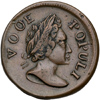 |
1760 Hibernia-Voce Populi Halfpenny. "VOOE POPULI". PCGS graded AU-53. Although not stated on the PCGS insert, this is the scarce VOOE variety, the C of VOCE was either first engraved backwards, or the O was used again instead of the correct C. After the error was noticed, the correct C was placed over the prior letter. Milk chocolate brown in color, with some darker colors embedded in the ample devices. Boldly struck on both sides, and this coin is medallic in appearance. One tiny mark over the error O on the obverse, this coin is far more choice than the average example.
Estimated Value $700 - 1,000.
No pedigree information available.
View details and enlarged photos
| Realized
$719 |
Lot 31 |
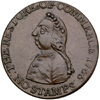 |
1766 Pitt Token Halfpenny. PCGS graded AU-58. These were struck to commemorate the victory of the American people over the stamp act. The obverse depicts Sir William Pitt, who defended the rebellious colonists in America by supporting their cause in Parliament. Pitt stated "as subjects they are entitled to the common right of representation, and cannot be bound to pay taxes without their consent,"--Pitt further demanded the Stamp Act be repealed, which it was soon thereafter. James Smither engraved the dies, allegedly from sketches by Paul Revere, and they were struck in either New York or Philadelphia.
Light chocolate brown in color and well struck by the dies, the surfaces are free of problems and the coin is highly desirable. A scarce coin in this grade, and worth a strong bid.
Estimated Value $2,500-UP.
No pedigree information available.
View details and enlarged photos
| Realized
$3,680 |
Lot 32 |
|
1766 Pitt Token Halfpenny. PCGS graded AU-55. Here is a resplendent example of this important colonial issue. Superb surface quality and color, and well struck too. Often found in lower grades, this coin will be the highlight of a colonial collection, and is certainly one of the finest circulated examples known. Don't miss viewing this coin and expect to pay a worthy premium.
Estimated Value $2,700 - 3,200.
View details
| Unsold |
Lot 33 |
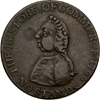 |
1766 Pitt Token Halfpenny. Del Bland graded VF-25. Quite well centered, only the tops of IENDS OF L are weak or worn smooth. Opposite the nose is a darkish spot, still very nice for the grade. Medium dark steel brown. A rare and desirable colonial issue, the lettering is easily readable, despite being a touch weak at the top. Seldom offered, and always in demand.
Estimated Value $900 - 1,350.
View details and enlarged photos
| Realized
$1,150 |
Lot 34 |
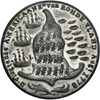 |
(c. 1779) Rhode Island Ship Medal, with wreath, pewter. PCGS graded MS-63. Breen states that about six are known of this variety struck in pewter. Most of those are in circulated grades, including the EF Garrett coin (Bowers & Ruddy Galleries, 10/80:1328). To find a choice mint state example that has been off the market for 55 years is something of a miracle. The surfaces are free of disturbing handling marks or other problems, and the coin has an even gray patina over lustrous fields. It is boldly struck and of utmost importance to the colonial specialist and one of the most desirable colonial coins in this extensive collection.
The PCGS Population Report notes only 4 examples of this have been graded, one is slightly better at MS-64, next is this coin, and below that are two other circulated pieces. The Guide Book states that "those struck in pewter are all rare and valued higher", but gives no estimate of market value. In Scott's Encyclopedia (1971) it states that only 2 are known. Breen enumerates 5 pieces, but notes that some duplication may be included in that list. The extensive Roper Collection (Stack's 1984) had a pewter example, but it was not the wreath below ship variety. These have been included in the American colonial issues for over a century, and are highly prized by specialists.
Free of tin pesting which so often mars pewter coins of this era, and graced by luster in the fields, and deeply struck devices. The only striking weakness is on the extreme high points of the ship port holes at the center of the vessel. One of the most important rarities in this colonial section, and worthy of a record price for the issue. So far as we know, no other pewter examples have been offered since the Roper coin in 1983, which as noted was a different variety.
Estimated Value $5,000-UP.
No pedigree information included, but most likely purchased in the mid 1940s privately.
View details and enlarged photos
| Realized
$11,500 |
Lot 35 |
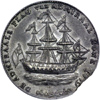 |
(c. 1779) Rhode Island Ship Medal, with wreath. PCGS graded MS-62. Here is another outstanding example of this popular colonial issue. The surfaces are a satiny gray color and the coin is boldly struck throughout. There is a mint made clip at the top of the date, visible on both sides, but it is small and unimportant. Breen estimates that only 6 are known with a question, PCGS reports only 5 have been graded of this variety, this is the third best with a couple of slightly better ones ahead. One for the specialist who demands top quality and rarity.
Estimated Value $2,500 - 3,000.
View details and enlarged photos
| Realized
$3,450 |
Lot 36 |
 |
(c. 1779) Rhode Island Ship Medal, with wreath. PCGS graded MS-62. These tokens were struck in England for a Dutch audience, in hopes the Dutch would not sign The Treaty Of Armed Neutrality (December 1780). The obverse design shows the Americans (with French naval support) retreating from Conanicut Island (near Newport) in 1778 pursued by the British under General William Howe's detachment that were occupying Rhode Island. A little over a year later, the Americans returned, and this time Howe's men and ships had to retreat. The legend loosely translates to "The Americans had to run away in 1778, now there goes Gen. Howe the same way in 1779" (Breen). Many of these apparently circulated in America, and few of these are known in mint state grades.
This is a rare coin in mint state, only two have been graded higher by PCGS, and this is the only coin in its grade category. We note some minor staining on the upper devices, most notable on the upper reverse, like a dark cloud at the top of the ship. Sharply struck and highly collectible in this grade.
Estimated Value $2,500-UP.
View details and enlarged photos
| Realized
$4,600 |
Lot 37 |
|
1783 Chalmers Shilling. Birds, short worm. PCGS graded AU-50. Deep gray in color and well struck for this issue. There is a small edge clip at the top of the obverse and bottom of the reverse and a couple of minor handling marks on both sides. One of the best graded by PCGS, only 5 have been graded this high, with a single coin grade higher.
Estimated Value $5,000 - 6,000.
View details
| Realized
$5,520 |
Lot 38 |
|
1741 French Colonies Half Sou Marque. EF-40. Choice silvery gray in color and with darker shades on the devices. Well preserved and seldom offered.
Estimated Value $200 - 250.
View details
| Realized
$322 |
Lot 39 |
|
1760 French Colonies Sou Marque. PCGS graded AU-50. Nice surfaces for the grade, with delicate blue tones in the lettering. Some weakness in the strike on the periphery.
Estimated Value $250 - 300.
View details
| Realized
$184 |
Lot 40 |
|
1721-H French Colonies Copper Sou. VF-30. Struck at the La Rochelle Mint in France from copper mined at the "Copper Mountain" in Falun above Stockholm (source of 2/3 of the copper ore used by European mints since it was discovered in 1347). Shipped over in mid-1722, most of the French colonists refused to accept these pieces (Breen). During that time, John Law was up to his famous attempt at paying off the French national debt with paper currency, and French money of all sorts was being devalued. The French troops stationed in Quebec were threatening to mutiny, and these coins were sent over to help avert this action. Fearing a further devaluation, these coins were not readily accepted, and did not widely circulate. Sharply struck at the centers and average in surface quality. One small rim mark on the top left of the reverse, and the planchet is slightly bent. Slightly porous and toned a medium and reddish brown on the obverse, more red on the reverse.
Estimated Value $200 - 300.
Purchased from Stack's 10/21/44 for $5.
View details
| Realized
$219 |
Lot 41 |
|
1767 French Colonies Sou. PCGS graded AU-55. These coins have turned up in non collector accumulations with other early colonials, so they apparently circulated in America during the 1780s. This one has light brown color and clean fields and devices. Over 98 percent of the original issue was counterstamped with the RF, and these circulated as cents in this country.
Estimated Value $400 - 500.
View details
| Realized
$368 |
Lot 42 |
 |
1783 Nova Constellation Copper. Pointed rays, small U.S. PCGS graded MS-62 Brown. Examination with a glass will note some minor surface corrosion on both sides, which caused the planchet to flake. Medium brown in color and generally free of handling marks or other problems. Sharply impressed and always popular for its decidedly American themes, this CONSTELLATIO NOVA or The New Constellation, surrounded by thirteen stripes and thirteen stars (the new American flag elements as passed by the Second Continental Congress). These were ordered from New York and designed by William Wyon, III and struck at the Birmingham Mint.
Estimated Value $2,500 - 3,250.
No pedigree information available, but likely purchased in the mid 1940s.
View details and enlarged photos
| Realized
$2,875 |
Lot 43 |
|
1783 Nova Constellation Copper. Pointed rays, small U.S. PCGS graded AU-55. This one has a great strike and color for the issue. The obverse depicts the all seeing eye of wisdom, surrounded by the stars representing the thirteen states, and these were struck under the authority of the Articles of Confederation. A glass will note the slightest roughness in the fields, but no handling marks or problems otherwise. Usually found in lower grades, this lovely AU-55 coin should please most any collector.
Estimated Value $1,200 - 1,500.
View details
| Realized
$1,208 |
Lot 44 |
|
1783 Nova Constellation Copper. Blunt rays. PCGS graded AU-50. Dark chocolate brown in color and with some very slight darkening around the devices. On the obverse there is a faint scratch through the upper left rays. About as nice as these are found, only 4 have been graded higher by PCGS, with 8 in the AU-50 slot. Well struck and overall a pleasing coin.
Estimated Value $1,000 - 1,200.
View details
| Realized
$1,093 |
Lot 45 |
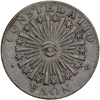 |
1783 Nova Constellation Copper. Blunt rays. Fine-15. On a problem-free planchet that boasts smooth even wear and delicate brown toning. Well struck and centered. Pleasing in every way.
Estimated Value $125 - 200.
Ex: Ira S. Reed, July 1944, at $2.
View details and enlarged photos
| Realized
$529 |
Lot 46 |
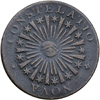 |
1783 Nova Constellation Copper. Blunt rays. VG-8. Dark olive in the fields and slightly porous, lighter brown on the upper devices. Well struck and generally pleasing for the grade.
Estimated Value $75 - 100.
Ex: Ira S. Reed, July 1944 at $2.
View details and enlarged photos
| Realized
$219 |
Lot 47 |
 |
1785 Nova Constellation Copper. Pointed rays. PCGS graded AU-58. Struck from rusted dies that also show a few minor die cracks. Medium brown in color and well preserved, without the usual porous surfaces or other problems. Seldom found this nice, and almost never better.
Estimated Value $1,500 - 2,500.
No pedigree information provided, but likely purchased in the mid 1940s.
View details and enlarged photos
| Realized
$2,185 |
Lot 48 |
|
1785 Nova Constellation Copper. Pointed rays. Good-5. This one was apparently burned in a fire and the planchet shows extensive cracks on both sides. Most of the devices are still visible, and the color is a medium brown. Inspection mandatory.
Estimated Value $50 - 75.
View details
| Realized
$40 |
Lot 49 |
 |
1787 Massachusetts Half Cent. PCGS graded MS-64 Brown. A scarce coin in this grade, the coin is well struck with most of the central devices present, although some are weak. Deep brown in color, with hints of original red near the devices. Exceptional surfaces, accounting for the grade, and without the usual problems of spotting or heavy handling marks. We note a very minor edge clip on the right side, near 3 o'clock on both the obverse and reverse.
Estimated Value $3,500-UP.
Ex: Syracuse Coin Shop, 1/41, price unknown.
View details and enlarged photos
| Realized
$6,325 |
Lot 50 |
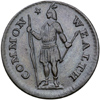 |
1787 Massachusetts Half Cent. PCGS graded AU-58. Choice medium brown in color and with most of the device detail sharp. HALF CENT is weak, but can be seen with the unaided eye. Excellent rims, fields and devices, which scarcely show any signs of contact or wear. Another outstanding colonial coin.
Estimated Value $1,800 - 2,500.
Ex: Ira S. Reed, 7/44 as "Very Fine" for $3.
View details and enlarged photos
| Realized
$1,438 |
|
|